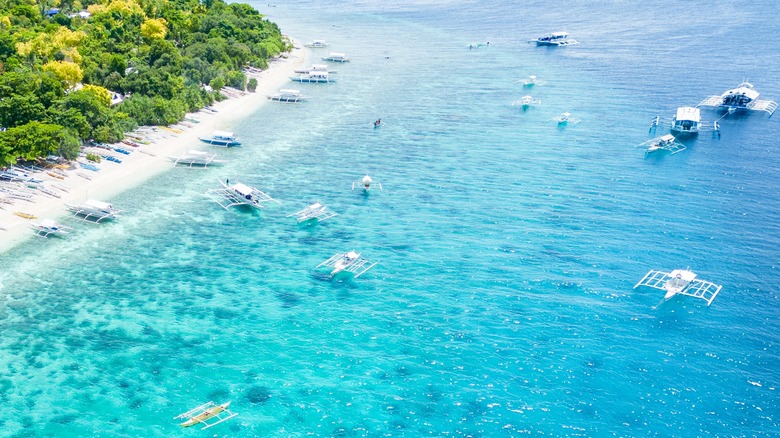The Dangerous Spots In The Ocean You Need To Avoid While Snorkeling
Snorkeling is often viewed as an exciting sport that anyone with the right equipment can quickly learn and enjoy while on vacation. But any time you are swimming in the ocean, it's important to take precautions. One of the best things you can do to keep yourself safe is to choose where you're going to snorkel carefully. While it's tempting to get right up close to reefs, you should do your best to avoid shallow waters where you are forced to swim right over them because of the risk of ocean surges. You should also never snorkel in areas where you're likely to end up in the path of an oncoming boat.
There are a lot of mistakes to avoid when snorkeling for the first time, but choosing the wrong part of the ocean to swim in — even if you're an experienced snorkeler — might be the most dangerous. It's especially vital that new snorkelers do their research and choose calm places to start snorkeling. With a little research, you can plan the ideal snorkeling trip that lets you see some of the most vibrant and biodiverse habitats on the planet without taking any unnecessary risks.
Avoid swimming too close to the reef
Snorkeling is an activity that is often enjoyed by people who don't normally spend much time in the water. That can be fine, especially if you review all the tips for non-swimmers to snorkel safely, but if trepidation about swimming leads you to stay in the shallows, you might actually be putting yourself at risk. Although swimming in deep waters might feel more dangerous, ocean surges can be hazardous for snorkelers swimming in shallow waters trying to get a closer look at coral reefs.
In fact, according to Panama City Diving, "You face the greatest danger when snorkeling in shallow reef waters" during ocean surges. These surges can happen at any time and are sudden waves that are more than capable of throwing people around who are floating on the surface of the water. If you are only inches away from the reef, a sudden surge can leave you with some very painful injuries. Keep a comfortable distance to ensure safety.
If you've done your research about how to safely snorkel around coral reefs, you already know that a human colliding with their natural habitat is obviously not good for the sea creatures. It can also be extremely dangerous for you. As described by the Divers Alert Network (DAN), some coral reefs are very sharp, and snorkelers are often injured by unintentionally brushing up against them. Being thrown into them with force by a powerful ocean surge would be much, much more painful.
Never snorkel in high traffic areas
In 2022, The Palm Beach Post reported that a snorkeler had been hit by a boat and that the propellers had wounded his legs and arms. He ended up losing an arm. Unfortunately, this is far from an isolated incident. While there are many dangers in the ocean, from shorebreaks to jellyfish stings, the biggest danger to snorkelers might not be the currents or the creatures in the water. Snorkelers are often looking down at what's under the water — and boats speeding along the surface can be extremely dangerous. Sometimes, even deadly.
Unfortunately, snorkelers floating horizontally on the surface can be very tricky to detect while boating. To keep yourself safe, research the areas that you are interested in snorkeling, and avoid anywhere where there may be a lot of boats, especially if they may not be expecting snorkelers in the water. The easiest way to do this is to only snorkel in areas designated for snorkeling where boats are not permitted.


